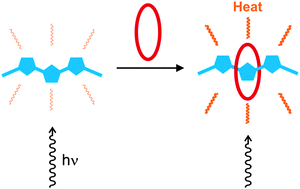Activated photothermal heating using croconaine dyes†
Abstract
Laser-induced photothermal heating is promoted by dyes or nanoparticles that strongly absorb light and convert it into heat. The best known near-infrared absorbing systems are gold nanorods and nanocages. The alternative strategy of using organic dyes to absorb the laser light has several inherent advantages due to the small molecular size and potential synthetic flexibility, but a major drawback is rapid photothermal bleaching. Here, we report three important findings: (a) near-infrared croconaine dyes exhibit outstanding properties for high performance photothermal heating; including an intense and narrow absorption band at around 800 nm, high chemical, photo- and thermal stability, very efficient relaxation to the ground state, and very low oxygen photosensitization ability. (b) Photothermal heating obeys the Beer–Lambert law (1 − 10−A) and sample heating reaches an asymptotic limit when chromophore absorbance values are greater than ∼1. (c) Croconaine dyes form red-shifted encapsulation complexes which allows the realization of molecular recognition induced activated photothermal heating, a broadly applicable nanoscale design concept that employs chemical or supramolecular processes to switch on laser-induced hyperthermia.


 Please wait while we load your content...
Please wait while we load your content...